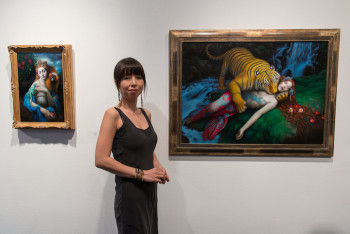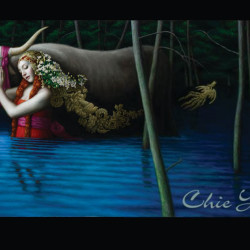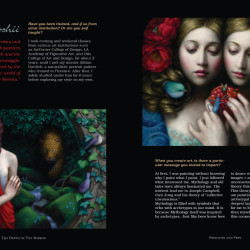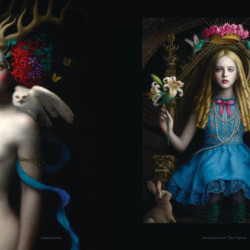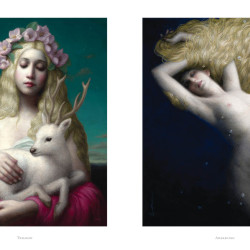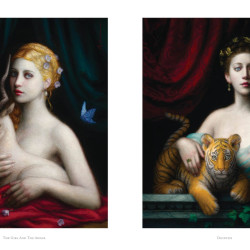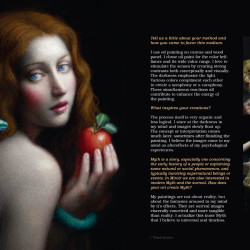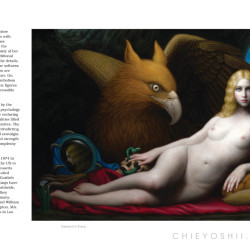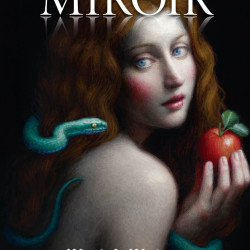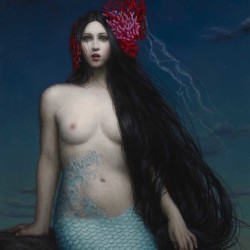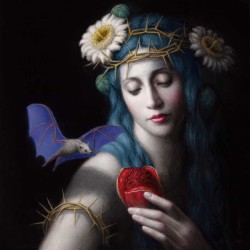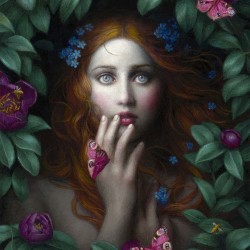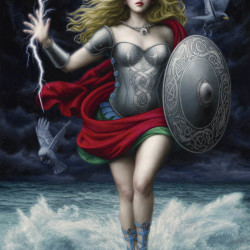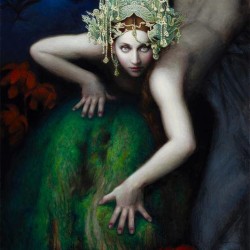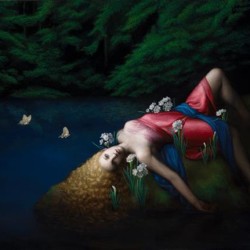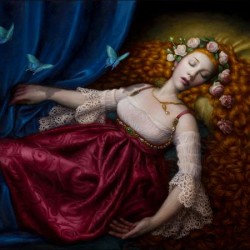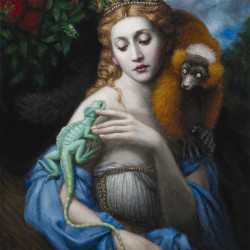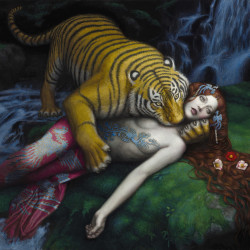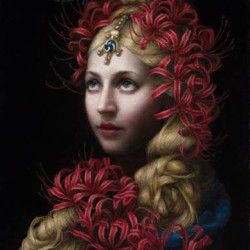Chie Yoshii’s oil paintings explore timeless psychological themes with a contrasting mix of techniques and styles. On the one hand, the brushstrokes and the luminosity of her panels are reminiscent of traditional Flemish paintings, in which the details, the quality of shading, and the softness of each character’s complexion are presented in a masterly manner. On the other hand, the subtle symbolism and compelling presence of the figures bring an unexpected air of accessible modernity.
Much of her work is inspired by the relationship between human psychology and mythical archetypes. The enduring themes are woven into surrealities filled with symbols and visual narratives. The enigmatic images embody contradicting elements such as novelty and nostalgia, innocence and sensuality, and strength and fragility, mirroring the complexity of our psyche.
Chie Yoshii was born in year 1974 in Kochi, Japan. She moved to the US to complete her BFA at Massachusetts College of Art in 2000 and studied with a realist painter Adrian Gottlieb from 2002 to 2008. Her paintings have been exhibited in galleries worldwide, including Dorothy Circus Gallery in Italy, Urban Nation in Germany, Thinkspace in Los Angeles, and William Baczek Fine Arts in Northampton, MA. She currently lives and works in Los Angeles.
Q: Have you been trained, and if so from what institution? Or are you self taught?
A: I took evening and weekend classes from various art institutions such as ArtCenter College of Design, LA Academy of Figurative Art, and Otis College of Art and Design, for about 2 years, until I met my mentor Adrian Gottlieb, a naturalistic portrait painter who trained in Florence. After that, I solely studied under him for 6 years before exploring my style on my own.
Q: Was your family supportive of your artistic endeavors?
A: Yes, I am lucky to have a wonderful, supportive family.
Q: Is there someone special who has encouraged your work and your path as an artist?
A: Not particularly, but many.
Q: Are there historic artists who influenced your style?
A: I love the brilliant colors and details of Flemish painters such as Jan van Eyck and the dramatic realism of Caravaggio. I also was influenced by the captivating mythic world of Gustave Moreau.
Q: Tell us a little about your method and how you came to favor this medium.
A: I use oil painting on canvas and wood panel. I chose oil paint for the color brilliance and its wide value range.
I love to stimulate the senses by creating strong contrasts both conceptually and visually.
The darkness emphasize the light. Various colors compliment each other to create a symphony or a cacophony. These simultaneous reactions all contribute to enhance the energy of the painting.
Q: When you create art is there a particular message you intend to impart?
A: At first, I was painting without knowing why I paint what I paint. I just followed what interested me. Mythology and old tales have always fascinated me. The interest lead me to Joseph Campbell, then Jung and his theory of “collective unconscious.”
Mythology is filled with symbols that echo with archetypes in our mind. It is because Mythology itself was inspired by archetypes. Just like bees know how to dance without learning, we all inherit images = archetypes in our collective unconsciousness. I understand Jung’s theory this way, and it rings true to me.
This theory made me realize that I am painting my interpretations of the archetypal images that we share in the deepest layer of the mind. It is a way for me to be a part of something bigger than myself. I wish the viewer can feel this connectedness as well.
Q: What inspires your creations?
A: The process itself is very organic and less logical. I stare at the darkness in my mind and images slowly float up. The concept or interpretation comes much later, sometimes after finishing the painting. I believe the images come to my mind as aftereffects of my psychological experiences.
Q: Myth a story, especially one concerning the early history of a people or explaining some natural or social phenomenon, and typically involving supernatural beings or events. In Miroir we are also interested in modern Myth and the surreal. How does your art create Myth?
A: My paintings are not about reality, but about the fantasies aroused in my mind by it’s effects. They are surreal images viscerally conceived and more tangible than reality. I actualize this inner Myth that I believe is universal and timeless.



